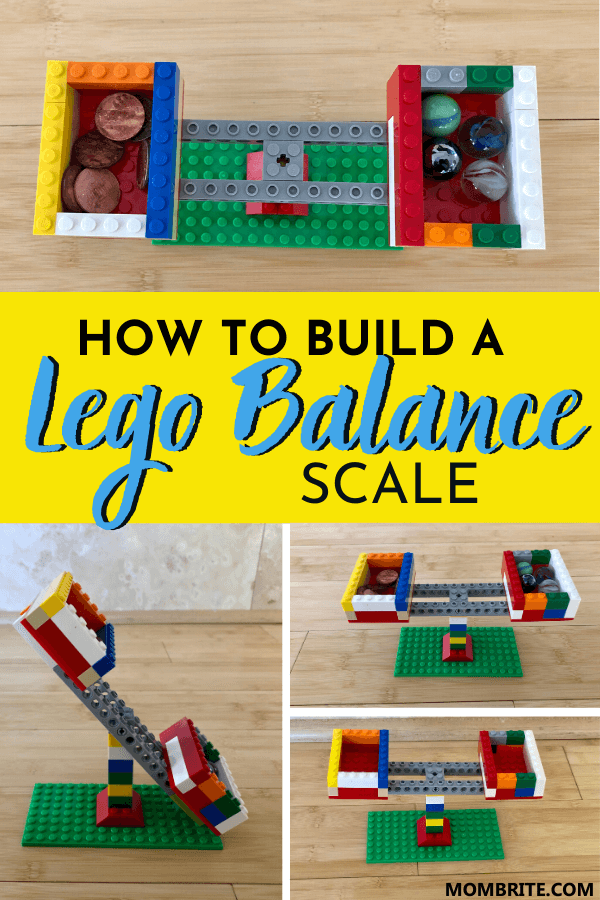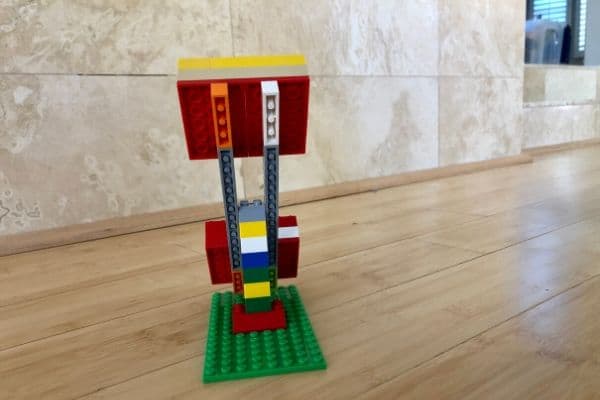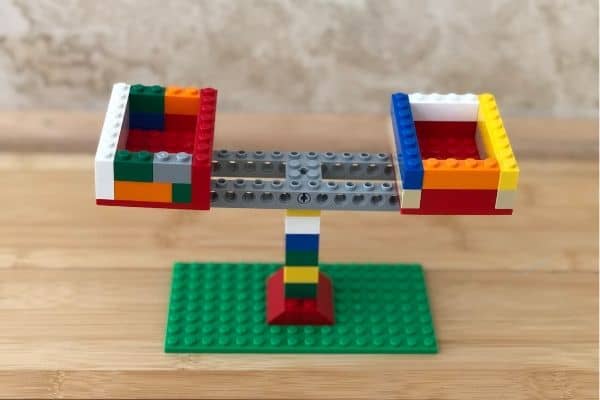Learn how to build a LEGO balance scale that actually works! Your little ones will adore this LEGO STEM activity that’s fun to make and experiment with.
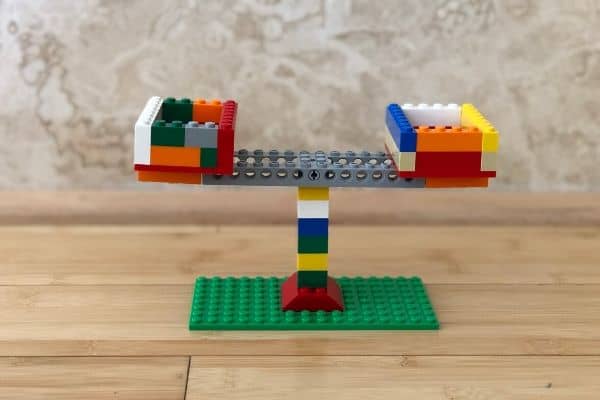
Due to our obsession with LEGO and our excuse of only spending money on 1 extracurricular activity versus our usual 10, I have decided that it’s time for some new LEGO pieces.
Specifically, ones that will allow us to build machines that MOVE.
After studying numerous LEGO sets, I went with Klutz Lego Chain Reactions Science & Building Kit. It comes with a book that teaches you how to use the bricks and most importantly, it has the essential pieces we need to build the contraptions I have in mind.
My son has been learning about comparing weights lately. To reinforce the concepts of “heavier” and “lighter,” we built a LEGO balance scale using our new bricks!
How to Build a LEGO Balance Scale
Materials:
- LEGO bricks
- LEGO Technic bricks with holes (we used 1×14, but you can use shorter ones like 1×12 or 1×10)
- LEGO Modified brick 2×2 with pins and axle hole (or you can use two LEGO Technic bricks 1×4 with holes and two connectors to imitate the modified brick)
- LEGO plate
- Optional: Food scale
Instructions:
- Attach the two 1×14 Technic bricks to the 2×2 modified brick.
- Build the two pans for the balance. You can build them bigger or smaller, but I used two 6×8 plates and created the perimeter two bricks high so things don’t fall out.
- Attach the pans to the two Technic bricks on each side of the balance. I didn’t attach the entire pan on the two bricks – I only used the 2 end studs of the Technic bricks.
- Stack 7 bricks beneath the modified brick to create the base of the scale. I did use two slope bricks instead to make it fancy looking but you don’t have to.
- Place the stack on the plate.
- Experiment by putting different objects on the scale!
Since we did the penny-washing experiment not that long ago, we had pennies sitting around. And we also have marbles closeby from the LEGO marble maze. So we used them to test out the scale.
We placed 3 marbles in one pan and slowly placed pennies on the other side one at a time until the scale balanced. You may want to place a finger lightly on the fulcrum (the center of the two Technic bricks where the lever pivots) to help the scale balance.
When we reached 6 pennies, the scale balanced.
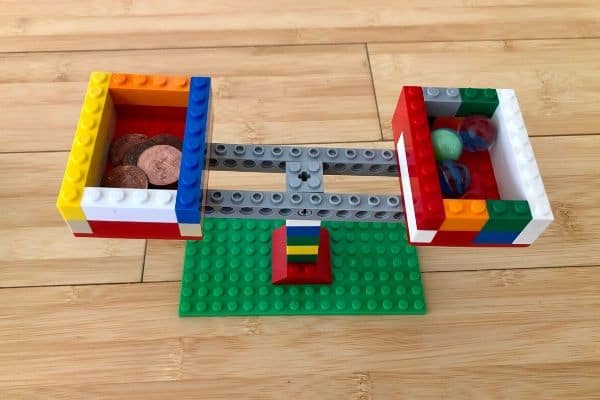
To test if our scale actually worked, or it was just a fluke, we got out our trusty kitchen food scale.
And guess what? 3 marbles came out to 0.55 ounces, and so did 6 pennies!
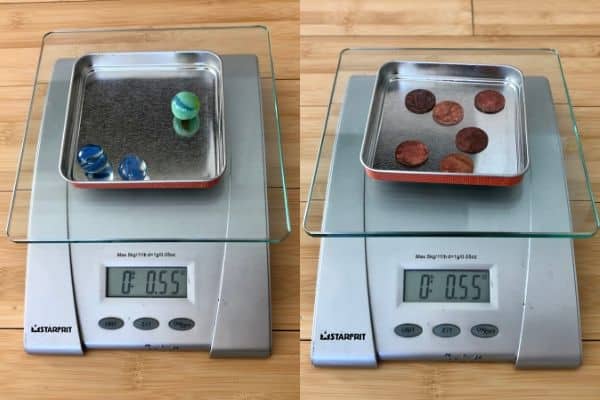
To double-check, we added one more marble and tried again to balance the scale with pennies on the other side. The scale balanced at 8 pennies.
And we weighed the 4 marbles and the 8 pennies and … drum roll, please … they both weighed 0.75 ounces! Success!
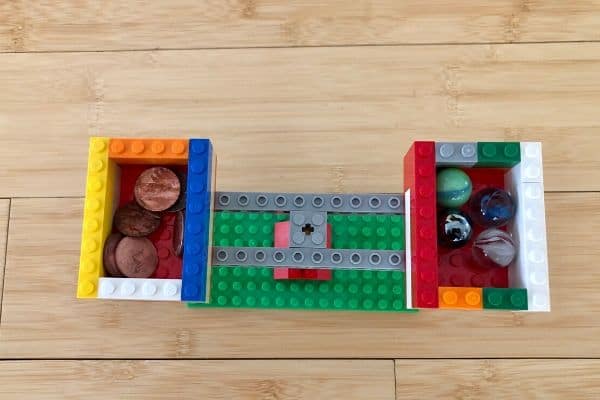
From this weight experiment, we can conclude that 1 marble weighs about 2 pennies. Who knew?
Science Behind the LEGO Balance Scale
A balance scale, similar to a seesaw, is a first-class lever. A lever is made out of a beam (Technic bricks), and in the case of first-class levers, the fulcrum, or the pivot, is placed between the two weights.
On one side, the weight is called the load. On the other side, the weight is called the effort.
In our experiment, think of the marbles as the load. In order to lift the load, we must increase the effort on the other side. When we put the pennies into the pan on the other side, we are increasing the effort and lifting the marbles up.
As we can see with our LEGO balance scale, the two arms of the lever need to be equal length and the effort must equal the load for the scale to balance. When the effort and the load balance each other, the level is in equilibrium.
Science Extensions
A balance scale is not as simple as it looks. Try these extensions with your kids:
- Move the fulcrum so that the two arms of the lever are not of equal length. How does that impact the amount of effort needed to balance the load?
- Try balancing different objects to see which one weighs more.
- Try changing the orientation of the objects to see if that affects the weight. For example, stand the pennies on its side instead of laying them flat in the pan.
- Try moving the pans closer to the fulcrum but keeping the arms of the lever the same length. Does that affect the load and effort?
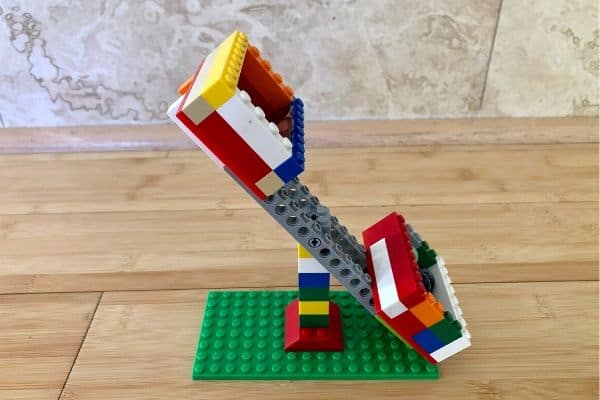
Final Thoughts on the LEGO Balance Scale
The Klutz Lego Chain Reactions Science & Building Kit certainly brought the LEGO STEM activities to a new level. We are excited to tackle new challenges, now with movable parts!
The LEGO balance scale is just the beginning. I am so glad that we did the balance scale so that my son could have a deeper understanding of what it means when things are heavier and lighter.
And some items are deceivingly heavy! But that gets into the concept of density, which we will for sure explore in the future.
YOU MAY LIKE:
